Laboratory Investigation of the Temperature-Dependent Mechanical Properties of a CRTS-Ⅱ Ballastless Track-Bridge Structural System in Summer
Abstract
1. Introduction
2. Test Model Overview
3. Experimental Content and Methodology
3.1. Monitoring Points
3.1.1. Temperature Measuring Points
3.1.2. Strain Measuring Points
3.1.3. Displacement Measuring Points
3.2. Test Procedure
4. Analysis of the Test Results
4.1. Track System Strain Analysis
4.2. Relative Displacement between the Track System Layers
4.2.1. Vertical Relative Displacement between Layers
4.2.2. Longitudinal Relative Displacement between Layers
4.3. Beam Deflection
5. Conclusions
- (1)
- The temperature of each structural layer of the track system changes with the change in the ambient temperature, showing a sine curve periodic change rule of increasing first and then decreasing; because of the poor thermal conductivity of the material, the temperature change in the track system lags behind the change in the ambient temperature, and the lag feature is more obvious with the increase in the depth from the top of the track slab.
- (2)
- During the 24-h test, the strain of each structural layer shows a sine curve periodic change of increasing first and then decreasing; because the strain time history law of the track system structure is affected by the hysteresis of the temperature change, the strain change of each structural layer has a certain lag along with the vertical depth. Due to the different temperatures at the beginning and end of the test, at 9:00 the next day, the strain of the track system structure at each location did not return to the initial state; the shear slots have a certain constraint on the track system structure, and the strain near the shear slot side of the structure is smaller than that on the other side.
- (3)
- Under the cyclic action of the temperature change in a single-day, the longitudinal and vertical relative displacements of the track system layers work together under the constraint of the beams, shear slots and track itself to realize the deformation of the track system; during the period from 17:00 to 23:00, the relative displacements of the whole layer are relatively small; due to the influence of the shear slots, the deformation of the track system and the relative displacement between the layers on the side near the shear slots (at section 0 L) are mostly realized by the track slab and CA mortar layer, while the relative displacement between the base plate and the beam body on the other side (at section L) is relatively large; the most unfavorable position is at section 1/4 L, where there is a peak value of the relative displacement between the layers, so this position should be considered.
- (4)
- Under the condition of high temperatures and no direct sunlight in summer, the deflection of the middle span of the CRTS II ballastless track simply supported box girder bridge structure system is the largest; the upper arch of the middle span section reaches 0.4 mm in the heating stage, and the lower deflection of the middle span section reaches 0.7 mm in the cooling stage. The deflection of the whole bridge in the cooling stage is slightly larger than that in the heating stage, so the cooling ratio has a significant impact on the deflection of the bridge.
- (5)
- For the existing ballastless track-bridge system, the structural displacement and deformation will lead to the change of ballastless track support state, which will lead to the change of track structure stress and force transmission mode and easily lead to track structure diseases. Therefore, it is suggested that the maintenance personnel should strengthen the inspection of the joints between the structural layers during the continuous high-temperature period, especially the inspection at 1/4 L, so as to grasp the best opportunity for maintenance and repair.
Author Contributions
Funding
Acknowledgments
Conflicts of Interest
References
- Zhou, L.Y.; Yang, L.Q.; Shan, Z.; Peng, X.S.; Akim, D.M. Investigation of the fatigue behaviour of a ballastless slab track-bridge structure system under train load. Appl. Sci. 2019, 9, 3625. [Google Scholar] [CrossRef]
- Zhao, L.; Zhou, L.Y.; Zhang, G.C. Experimental Study of the Temperature Distribution in CRTS-II Ballastless Tracks on a High-Speed Railway Bridge. Appl. Sci. 2020, 10, 1980. [Google Scholar] [CrossRef]
- Guo, W.; Hu, Y.; Gou, H.Y. Simplified seismic model of CRTS II ballastless track structure on high-speed railway bridges in China. Eng. Struct. 2020, 211, 110453. [Google Scholar] [CrossRef]
- Xiao, H.; Zhang, Y.R.; Li, Q.H. Analysis of the initiation and propagation of fatigue cracks in the CRTS II slab track inter-layer using FE-SAFE and XFEM. Proc. Inst. Mech. Eng. Part F J. Rail Rapid Transit. 2019, 233, 678–690. [Google Scholar] [CrossRef]
- Zhang, M.-N.; Hu, Z.-P.; Wu, Y.-B. Influence of Pier Temperature Increase on Jointless Track of Large-Span Bridge with High-Pier. Railw. Stand. Des. 2014, 58, 32–35. [Google Scholar]
- Chen, Z.; Xiao, J.L.; Liu, X.Y. Deformation behavior of slab warping for longitudinal continuous rigid slab under temperature effect. Adv. Struct. Eng. 2019, 22, 2823–2836. [Google Scholar] [CrossRef]
- Westgate, R.; Koo, K.Y.; Brownjohn, J. Effect of Solar Radiation on Suspension Bridge Performance. J. Bridge Eng. 2015, 20, 04014077. [Google Scholar] [CrossRef]
- Wang, J.; Zhou, Y.; Wu, T. Performance of Cement Asphalt Mortar in Ballastless Slab Track over High-Speed Railway under Extreme Climate Conditions. Int. J. Geomech. 2019, 19, 04019037. [Google Scholar] [CrossRef]
- Gonzales, I.; Ulker-Kaustell, M.; Karoumi, R. Seasonal effects on the stiffness properties of a ballasted railway bridge. Eng. Struct. 2013, 57, 63–72. [Google Scholar] [CrossRef]
- Tong, M.; Tham, L.G.; Au, F.T.K. Numerical modelling for temperature distribution in steel bridges. Comput. Struct. 2001, 79, 583–593. [Google Scholar] [CrossRef]
- Semendary, A.A.; Steinberg, E.P.; Walsh, K.K. Effects of Temperature Distributions on Thermally Induced Behavior of UHPC Shear Key Connections of an Adjacent Precast Prestressed Concrete Box Beam Bridge. J. Bridge Eng. 2019, 24, 04018115. [Google Scholar] [CrossRef]
- Cai, X.P.; Luo, B.C.; Zhong, Y.L. Arching mechanism of the slab joints in CRTSII slab track under high temperature conditions. Eng. Fail. Anal. 2019, 98, 95–108. [Google Scholar] [CrossRef]
- Ou, Z.; Sun, L. Value of Temperature Loads on Probability Demand for Ballastless Track Slab Ⅱ: Thermal Gradient Actions. J. China Railw. Soc. 2018, 40, 80–86. [Google Scholar]
- Stancik, V.; Ryjacek, P.; Vokac, M. Thermal and load rate-dependent interaction between embedded rail system and bridge. Proc. Soc. Mech. Eng. 2019, 233, 326–336. [Google Scholar] [CrossRef]
- Jiang, H.L.; Zhang, J.W.; Zhou, F. Optimization of PCM coating and its influence on the temperature field of CRTSII ballastless track slab. Constr. Build. Mater. 2020, 236, 117498. [Google Scholar] [CrossRef]
- Mirambell, E.; Aguado, A. Temperature and Stress Distributions in Concrete Box Girder Bridges. J. Struct. Eng. 1990, 116, 2388–2409. [Google Scholar] [CrossRef]
- Dai, G.; Su, H.; Liu, W. Temperature Distribution of Longitudinally Connected Slab Ballastless Track on Bridge in Summer. J. Cent. South Univ. Sci. Technol. 2017, 4, 1073–1080. [Google Scholar]
- Liu, W.S.; Dai, G.L.; Rao, S.C. Numerical calculation on solar temperature field of a cable-stayed bridge with U-shaped section on high-speed railway. J. Cent. South Univ. 2014, 21, 3345–3352. [Google Scholar] [CrossRef]
- Dai, G.-L.; Su, H.-T.; Yan, B. Experimental Study on the Vertical Temperature Gradient of Longitudinally Connected Slab Ballastless Track on Bridge in Autumn. J. Hunan Univ. Nat. Sci. Ed. 2015, 42, 94–99. [Google Scholar]
- Liu, F.; Zeng, Z.; Wu, B. Study on Temperature Field of Continuous Ballastless Track for High-Speed Railway. J. Railw. Soc. 2016, 12, 87–93. [Google Scholar]
- Zhong, Y.L.; Gao, L.; Zhang, Y.R. Effect of daily changing temperature on the curling behavior and interface stress of slab track in construction stage. Constr. Build. Mater. 2018, 185, 638–647. [Google Scholar] [CrossRef]
- Wang, S.; Sun, L.; Li, Q. Temperature Measurement and Temperature Stress Analysis of Ballastless Track Slab. J. Railw. Soc. 2009, 2, 52–55. [Google Scholar]
- Salcher, P.; Pradlwarter, H.; Adam, C. Reliability assessment of railway bridges subjected to high-speed trains considering the effects of seasonal temperature changes. Eng. Struct. 2016, 126, 712–724. [Google Scholar] [CrossRef]
- Zhu, J.S.; Guo, X.D.; Meng, Q.L. Analysis of fine temperature field for bridge-track system of high-speed railway. China Railw. Sci. 2019, 40, 36–45. [Google Scholar]
- Cardona, M.; Kremer, R.K. Temperature dependence of the electronic gaps of semiconductors. Thin Solid Films 2014, 571, 680–683. [Google Scholar] [CrossRef]
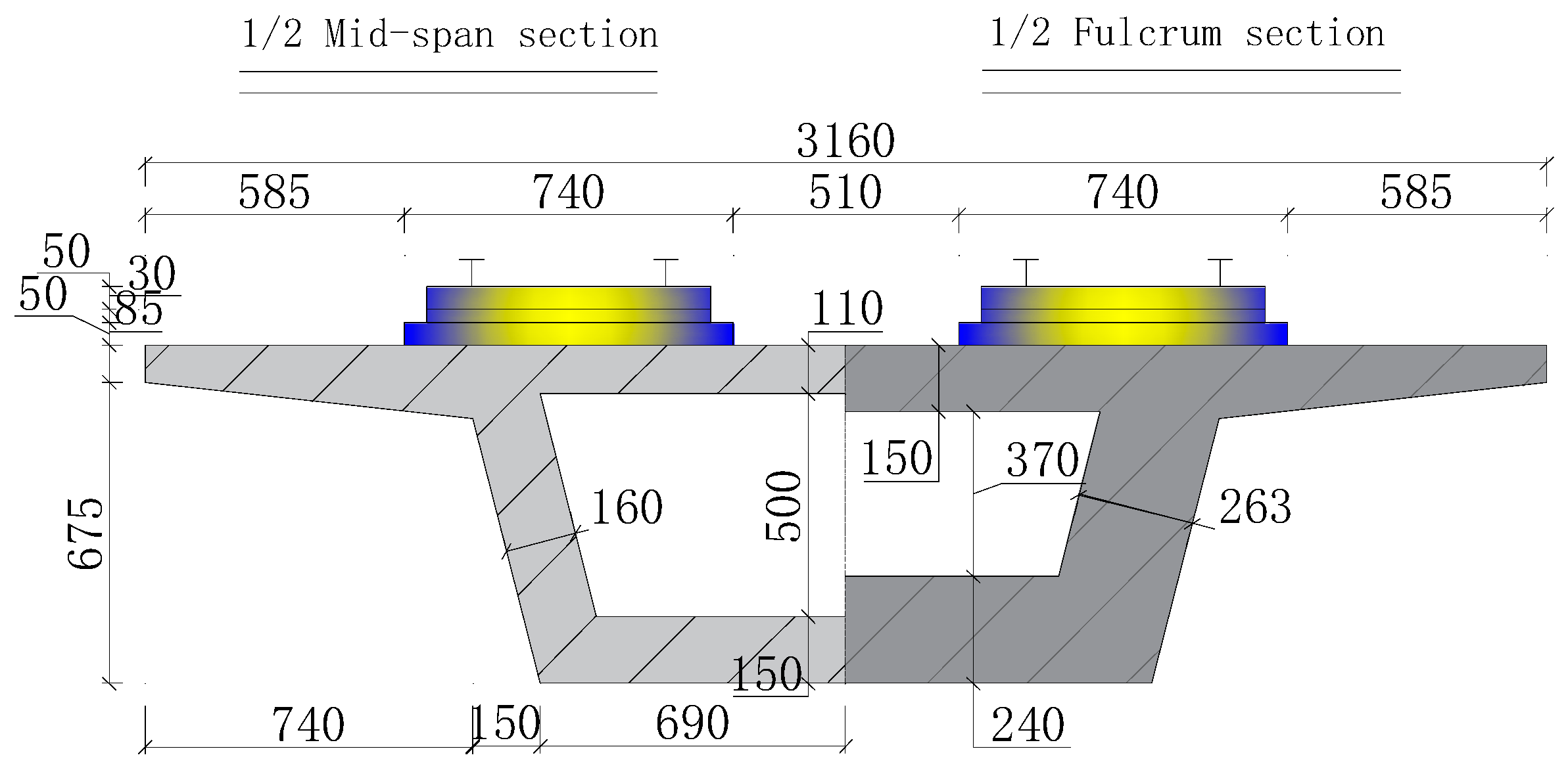
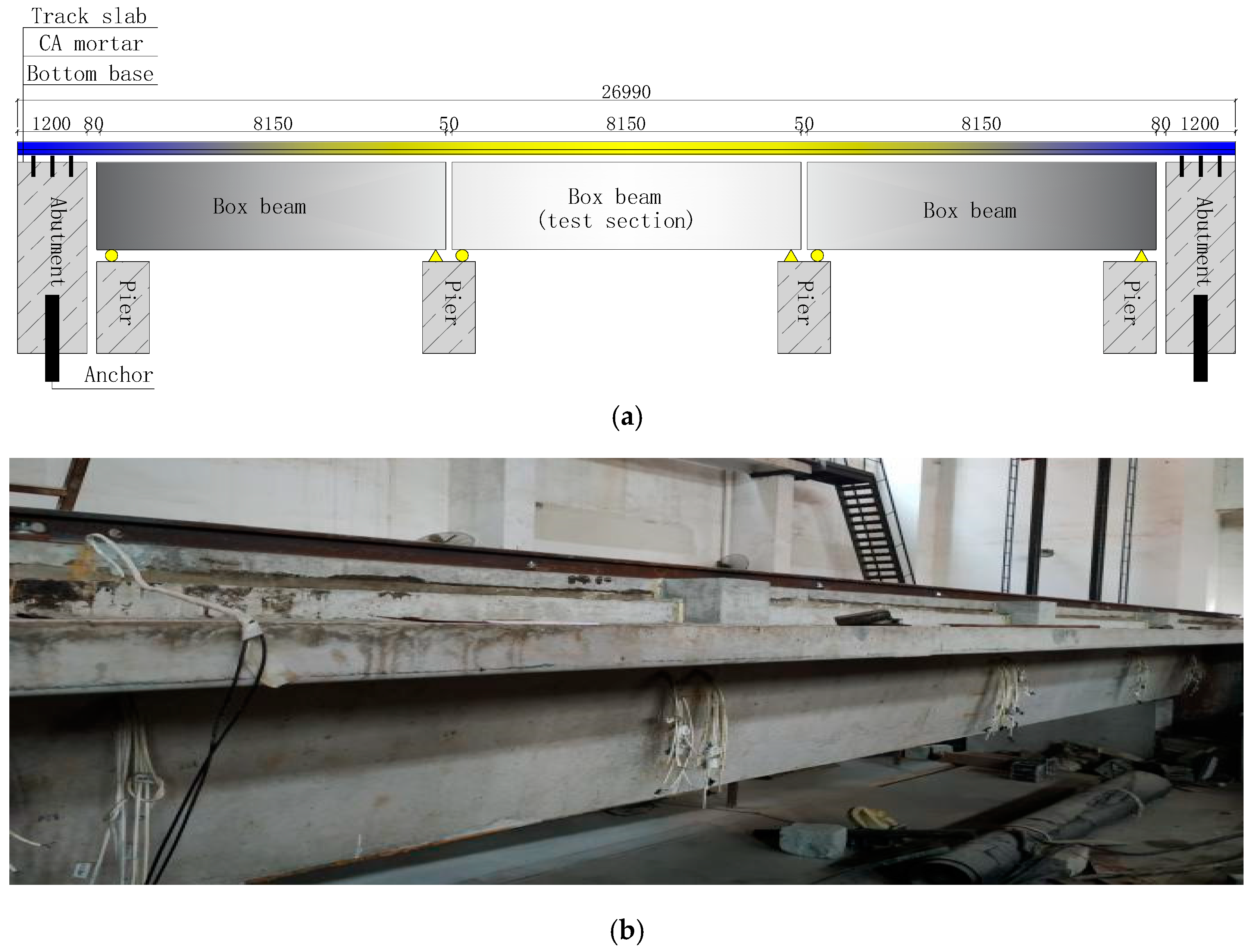


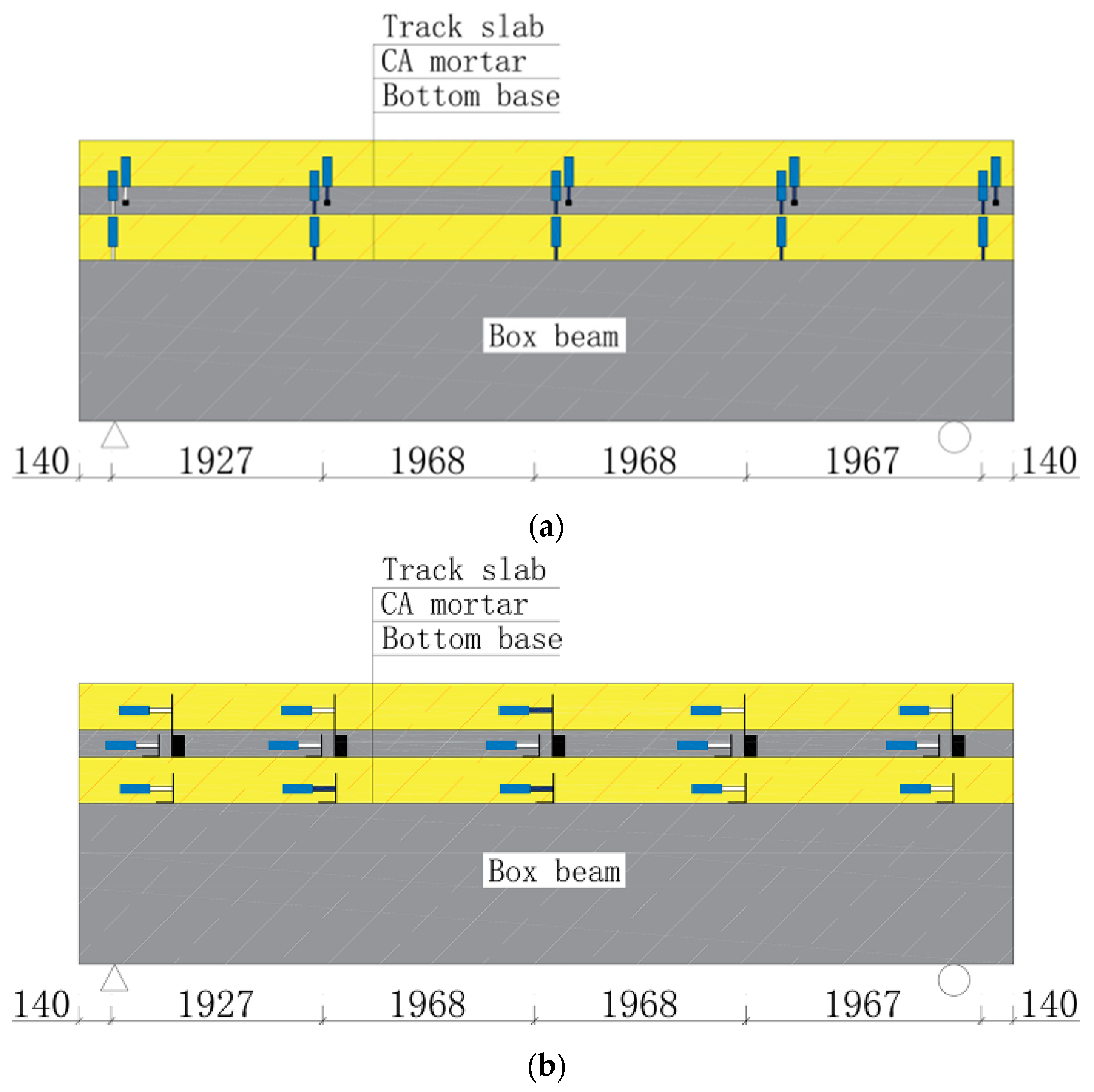
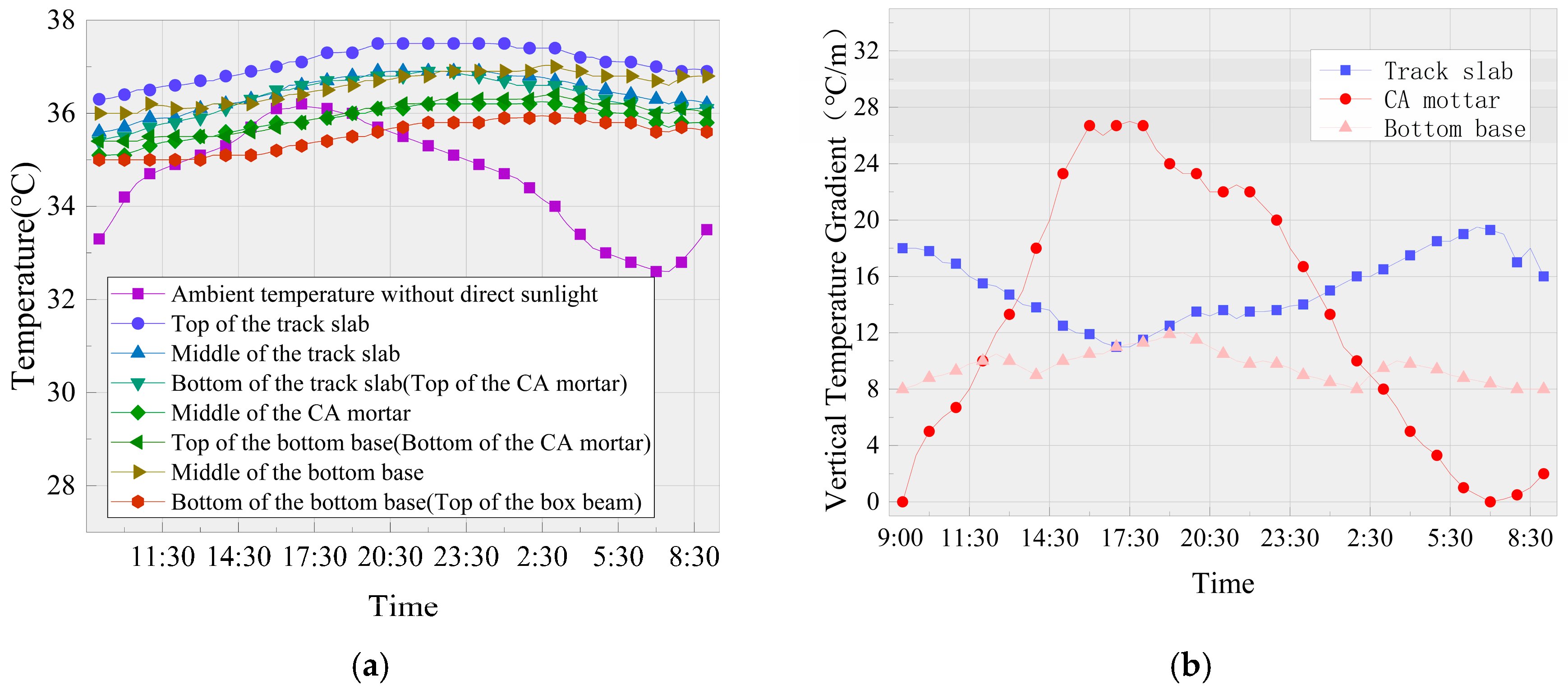
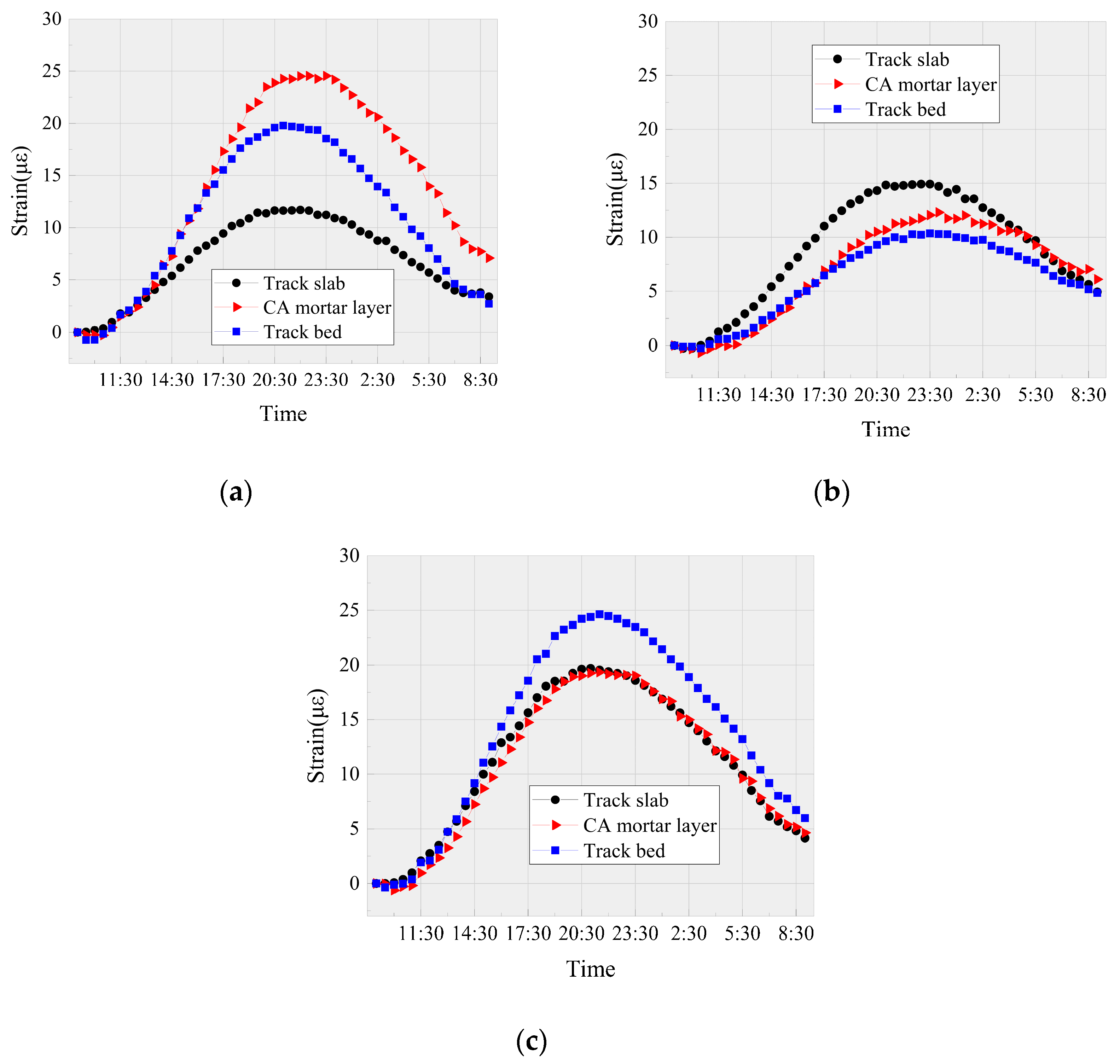
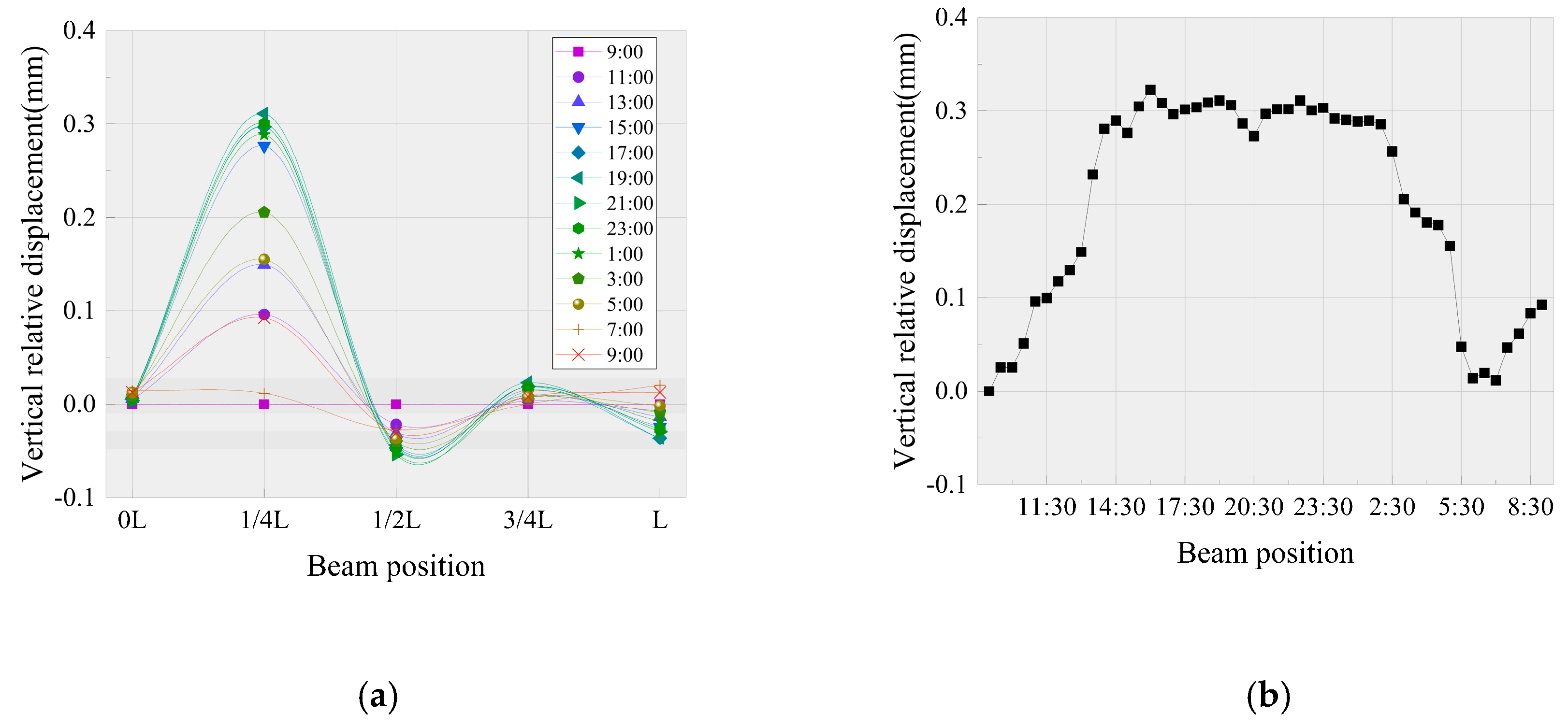

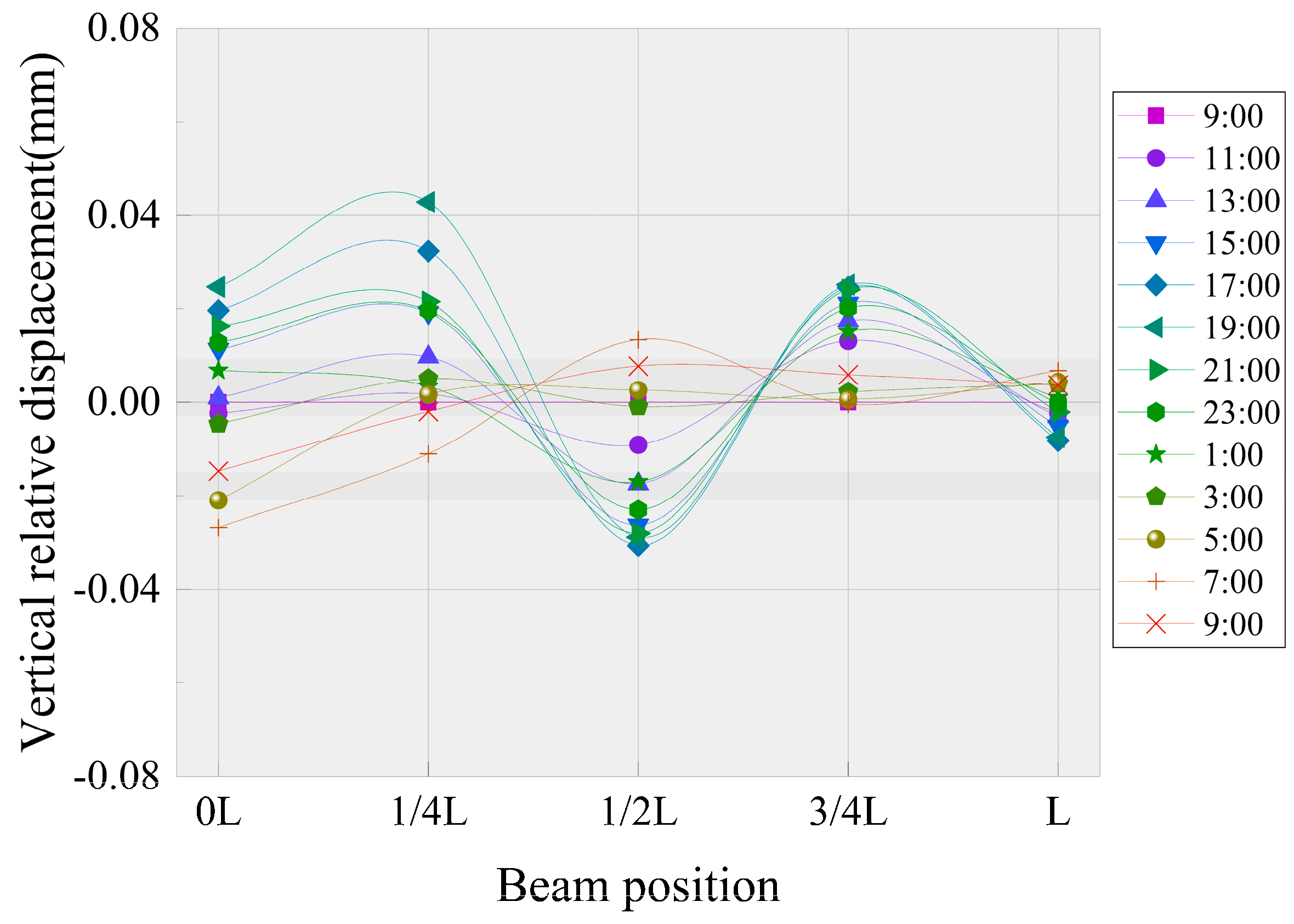
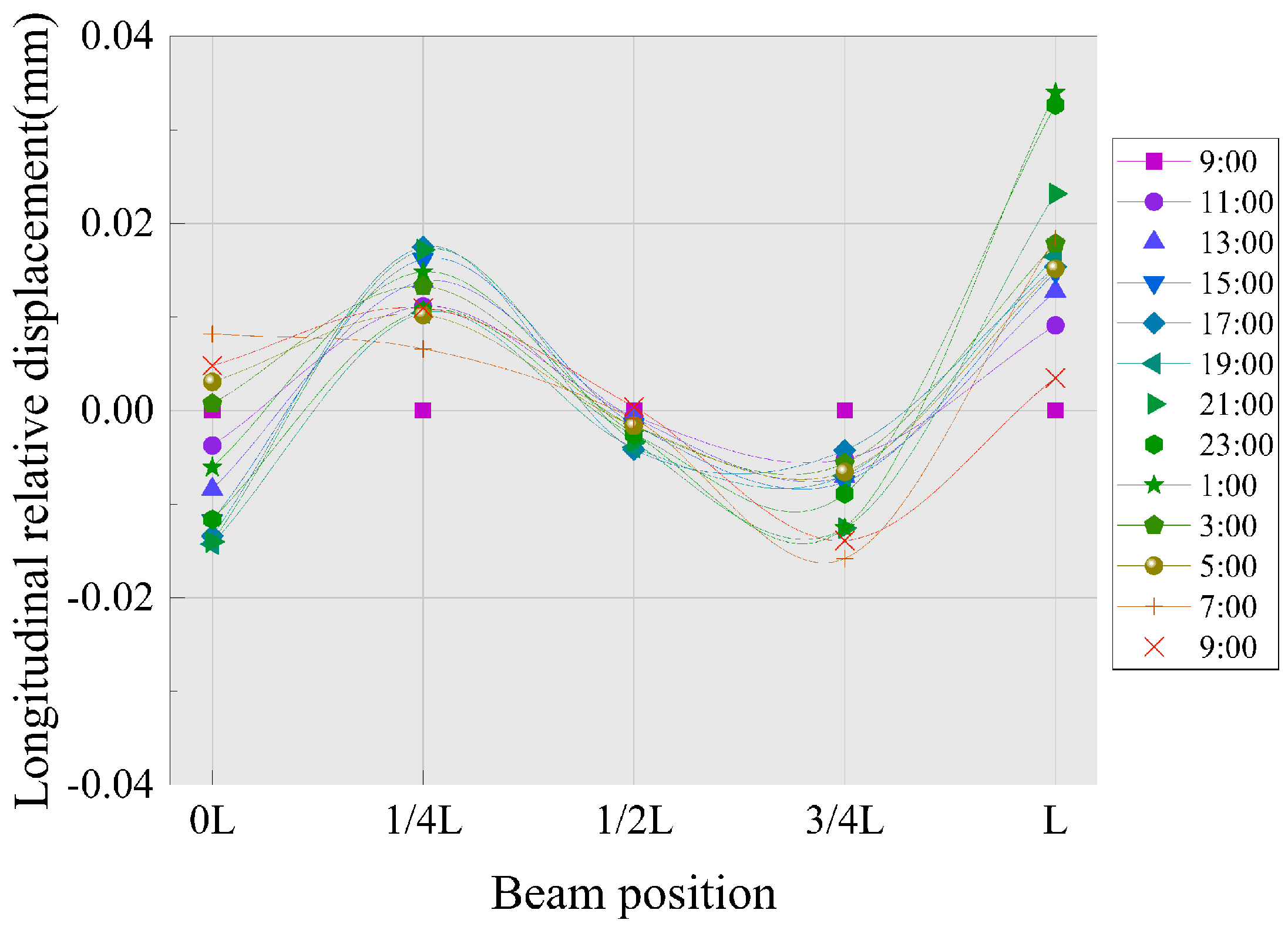
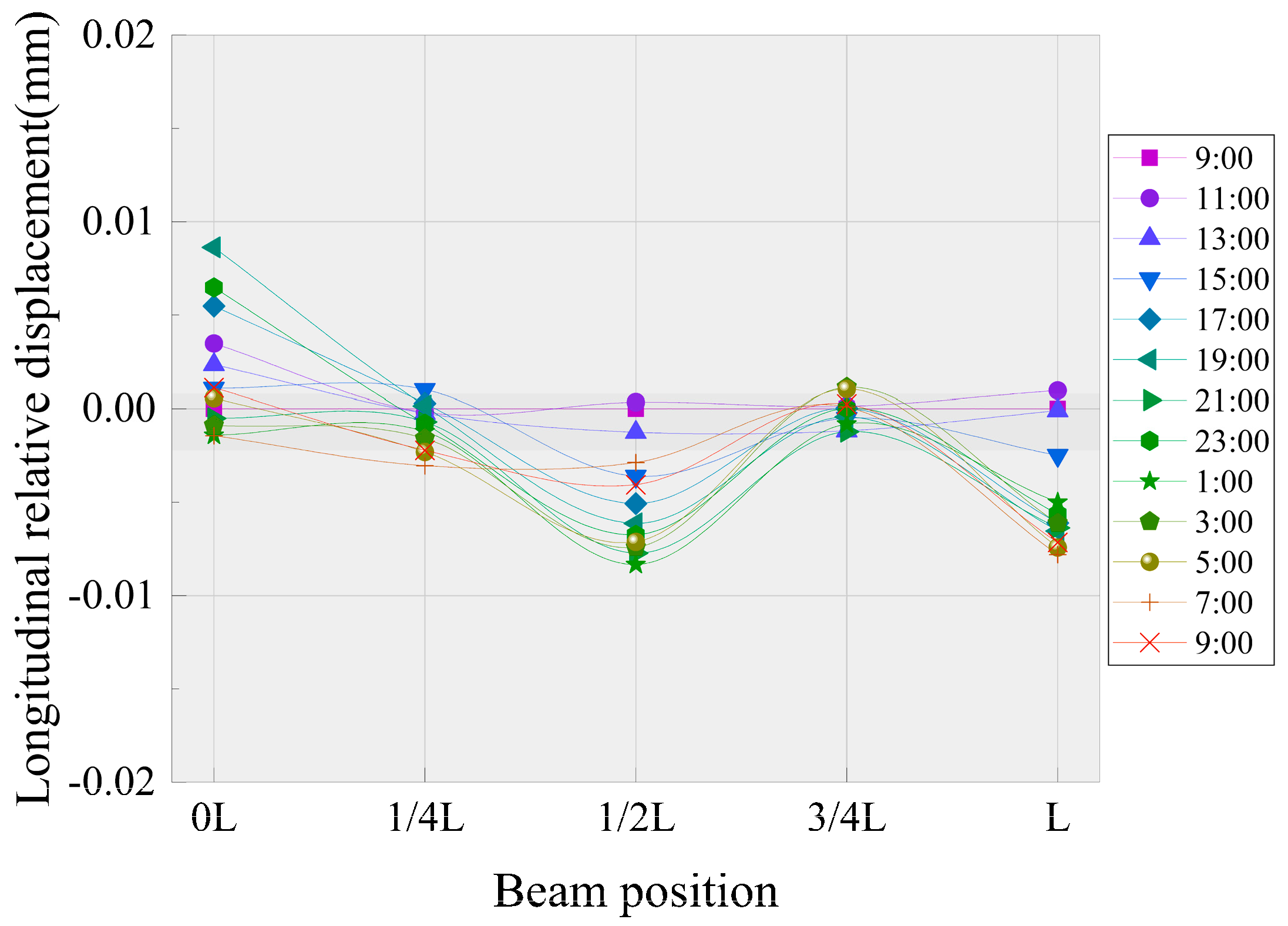
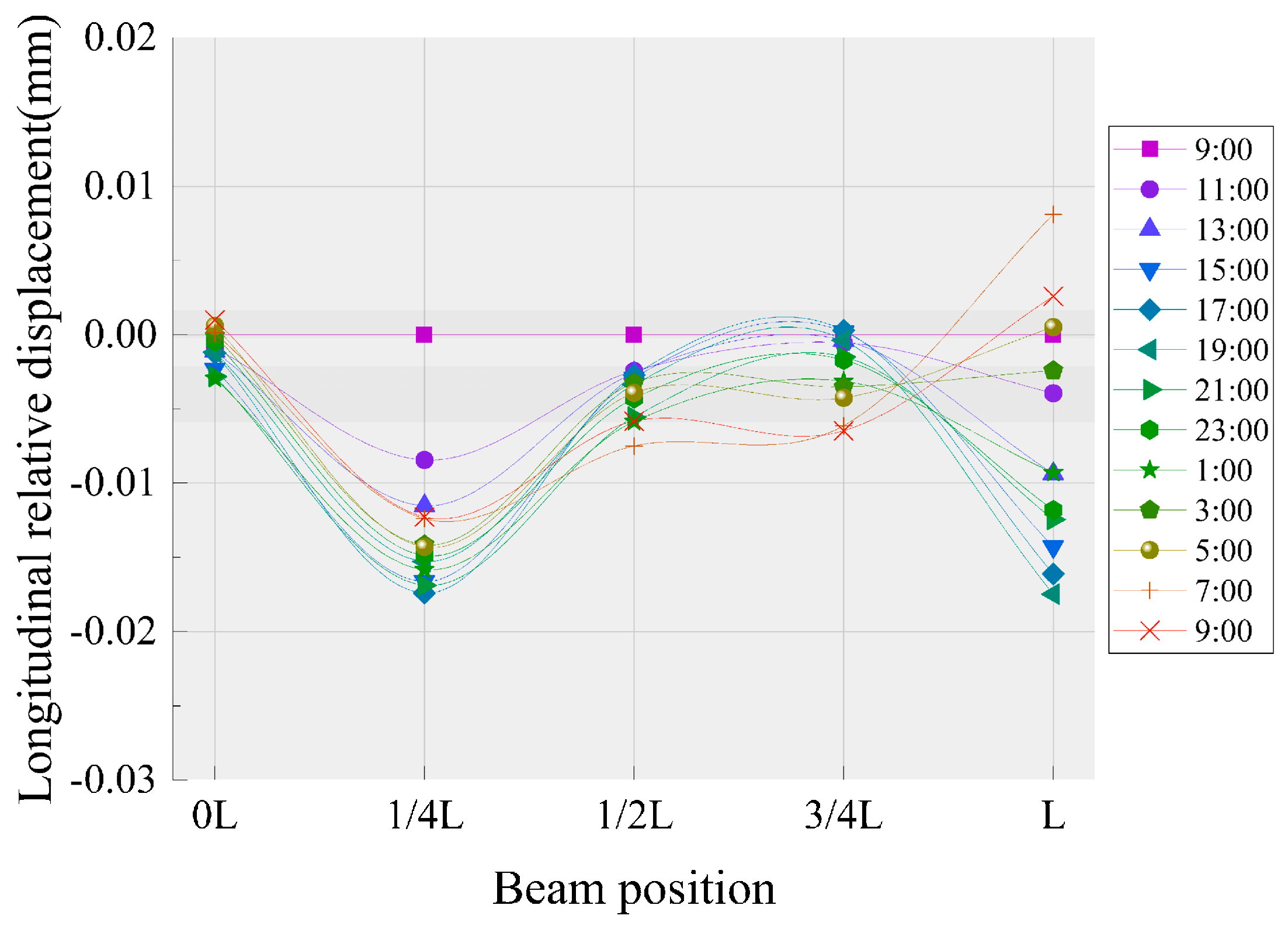
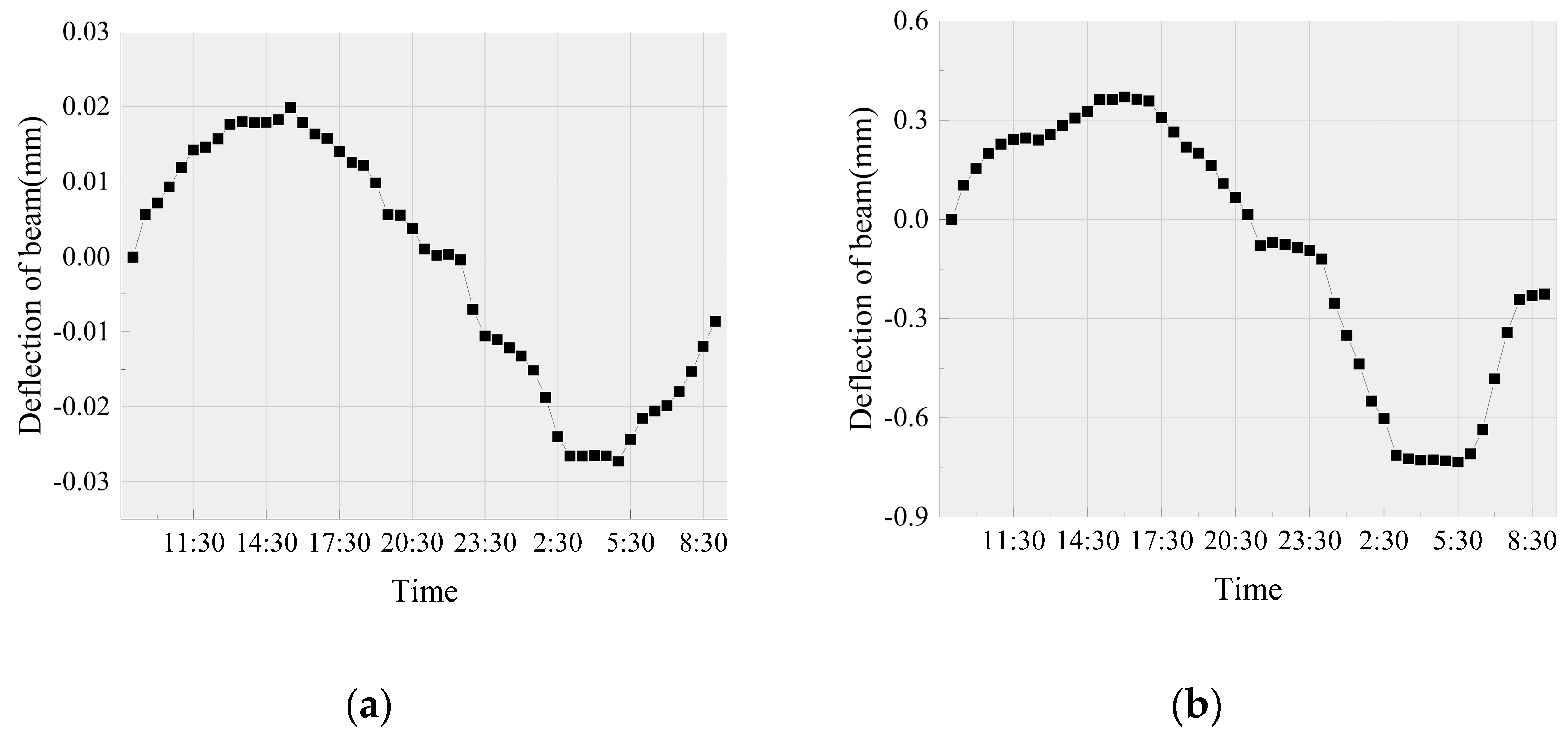
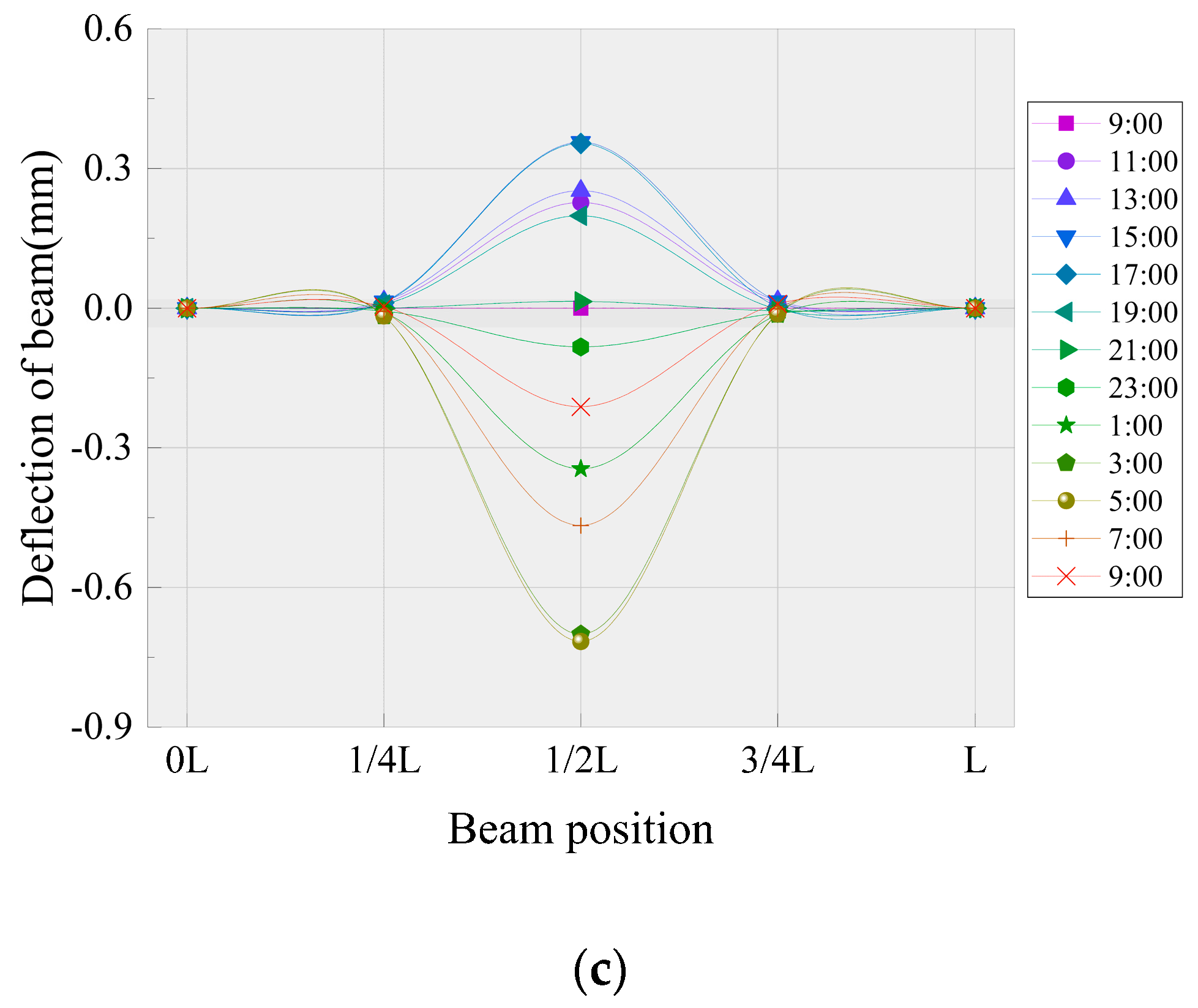
© 2020 by the authors. Licensee MDPI, Basel, Switzerland. This article is an open access article distributed under the terms and conditions of the Creative Commons Attribution (CC BY) license (http://creativecommons.org/licenses/by/4.0/).
Share and Cite
Zhou, L.; Yuan, Y.; Zhao, L.; Mahunon, A.D.G.; Zou, L.; Hou, W. Laboratory Investigation of the Temperature-Dependent Mechanical Properties of a CRTS-Ⅱ Ballastless Track-Bridge Structural System in Summer. Appl. Sci. 2020, 10, 5504. https://doi.org/10.3390/app10165504
Zhou L, Yuan Y, Zhao L, Mahunon ADG, Zou L, Hou W. Laboratory Investigation of the Temperature-Dependent Mechanical Properties of a CRTS-Ⅱ Ballastless Track-Bridge Structural System in Summer. Applied Sciences. 2020; 10(16):5504. https://doi.org/10.3390/app10165504
Chicago/Turabian StyleZhou, Lingyu, Yahui Yuan, Lei Zhao, Akim Djibril Gildas Mahunon, Lifan Zou, and Wenqi Hou. 2020. "Laboratory Investigation of the Temperature-Dependent Mechanical Properties of a CRTS-Ⅱ Ballastless Track-Bridge Structural System in Summer" Applied Sciences 10, no. 16: 5504. https://doi.org/10.3390/app10165504
APA StyleZhou, L., Yuan, Y., Zhao, L., Mahunon, A. D. G., Zou, L., & Hou, W. (2020). Laboratory Investigation of the Temperature-Dependent Mechanical Properties of a CRTS-Ⅱ Ballastless Track-Bridge Structural System in Summer. Applied Sciences, 10(16), 5504. https://doi.org/10.3390/app10165504




